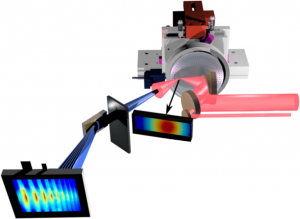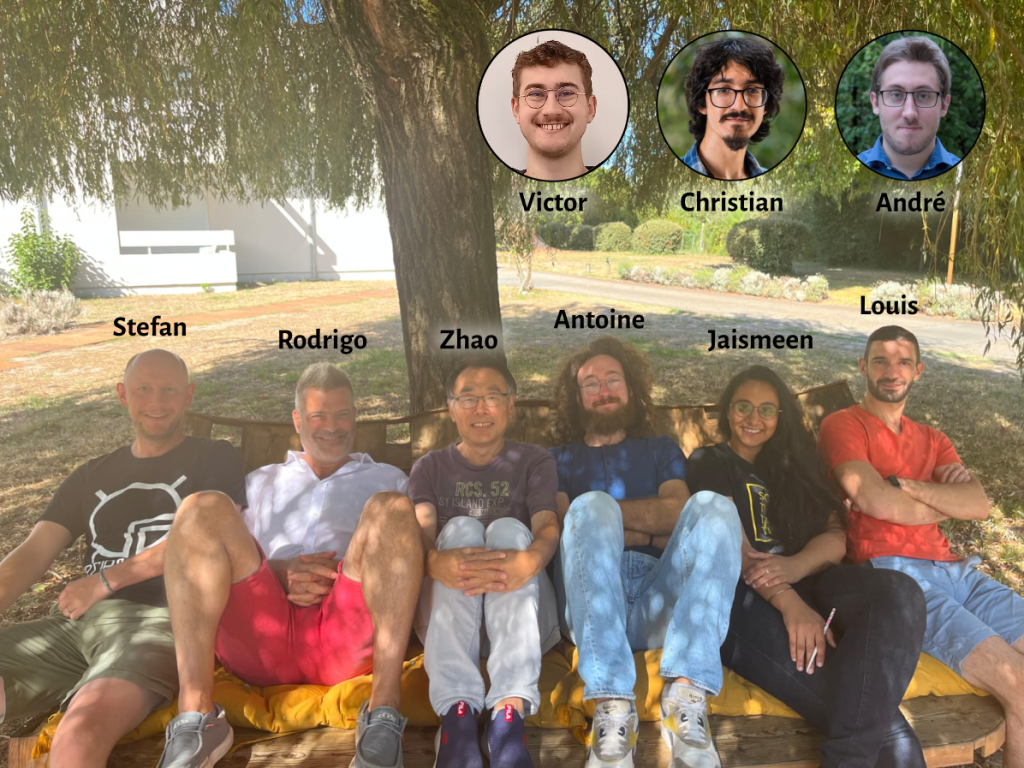Optical-Cycle Physics (PCO)
The PCO group was created in 2005 on the impetus given by Excellence Chair grant of Gérard Mourou, director of the LOA at the time and in 2018 laureate of the Nobel Prize in Physics. We study the interaction of a very intense laser with matter with the objective to follow and control the collective movement of relativistic electrons (with a velocity close to the speed of light) on a time scale below an oscillation cycle of our laser light – which is what gives our group its name. This time scale is measured in attoseconds, i.e. billionths of a billionth of a second = 10-18 s.

Therefore, we develop laser technologies which we unite in the « Salle Noire » : a laser producing a thousand pulses per second, each of which contains barely more than a single light wave oscillation cycle. In technical terms, this is a laser with a central wavelength of 780 nm (the optical cycle is 2.6 fs long) and a minimal pulse duration of 3.5 fs, with a stable carrier-envelope phase and a repetition rate of 1 kHz. Its peak power of a terawatt (1012 W) and its extremely high temporal contrast make it a worldwide unique laser of its kind.
This laser performance lets us create extreme conditions in plasmas, uniting gigantic forces that accelerate electrons quasi-instantaneously to relativistic velocities with fine control on the attosecond time scale. We are particularly interested in dense plasmas created at the surface of solid targets, which behave as relativistic oscillating mirrors in such a way as to temporally compress the oscillations of the reflected light.
This temporal compression adds to the laser light new frequencies in the extreme-ultraviolet (XUV) range, and does so in the form of attosecond flashes. These flashes are of great interest for observing the extremely fast movement of electrons in atoms, molecules or solids, during a chemical reaction or a transition between quantum states.
Another perspective is opened when the attosecond pulses carry a large part of generating laser energy, thus further boosting the peak power. As moreover XUV light can be focused to much smaller sizes than visible light, it may thus become possible to reach new record light intensities and enter a regime where photons interact among each other, or even with the vacuum. The research done within the PCO group contributes to explore also this domain, which bears potential for major new discoveries.

Attosecond physics on relativistic plasma mirrors
Attosecond physics on relativistic plasma mirrors When focusing the “Salle Noire” laser with an off-axis parabola of aperture f/1.5 onto

Laser development : ultra-short and ultra-intense
Laser development : ultra-short and ultra-intense The laser used to attain ultra-high, so-called relativistic intensities are almost always lasers amplified
Group members
- Dr. Rodrigo Lopez-Martens (Group leader, IR Polytechnique) CV HAL Google Scholar
- Dr. Stefan Haessler (CR CNRS) CV HAL Google Scholar Github
- Dr. Louis Daniault (IR Polytechnique) Google Scholar
- Dr. Jaismeen Kaur (IR CNRS) Google Scholar
- Antoine Cavagna (Doctoral researcher)
- André Kalouguine (Doctoral researcher)
- Victor Koltalo (Doctoral researcher)
- Christian Cabello (Master student)

Alumni :
- Clara Garcia (research intern, -> PhD at ILM Lyon)
- Dr. Jaismeen Kaur (PhD 2021-2024, -> IR CNRS avec nous)
- Meenakshi Mini Ashok (Master 2024, -> PhD at DESY)
- Dr. Marie Ouillé (PhD 2018-2022, -> postdoc at RIKEN)
- Dr. Zhao Cheng (IR2 CNRS 2 2018-2023, -> engineer at VIULASE )
- Dr. Brigitte Mercier (IR1 CNRS, 2009-2020, -> retired)
- Dr. Jean-Philippe Rousseau (IR1 Polytechnique, 2009-2020, -> retired)
- Anthony Guillaume (Master 2019, -> software engineer at Nokia)
- Dr. Jean-Baptiste Margoto (PhD 2016—2019, -> engineer at ITEOX)
- Dr. Frederik Böhle (PhD 2013—2017, -> engineer at Menlo Systems)
- Dr. Maïnmouna Bocoum (PhD 2013—2016, -> CNRS researcher at Institut Langevin)
- Dr. Hermance Jacqmin (PhD 2013—2016, -> engineer at Onera)
- Dr. Aurélie Jullien (CR CNRS 2008–2015, -> moved to Institut de Physique de Nice)
- Prof. Olivier Albert (Prof. ENSTA 2008—2014, -> engineer at Fastlite)
- Dr. Antonin Borot (PhD 2010—2013, -> co-founder of SourceLab, and Unistellar Optics)
- Dr. Aurélien Ricci (PhD 2010—2013, -> co-founder of SourceLab and Décor World Services)
- Dr. Arnaud Malvache (PhD 2008—2011, -> CR CNRS, co-founder of Unistellar Optics)
- Dr. Jonathan Wheeler (Postdoc 2010-2011, -> postdoc at IZEST, now IR CNRS at LOA)
- Dr. Lorenzo Canova (PhD 2007—2010, -> engineer Saint Gobain)
- Dr. Xiaowei Chen (Postdoc 2008-2010, -> Amplitude Technologies)


